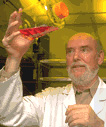Skin Cancer Scientist Sees Ray of Hope: A Conversation with James Cleaver

James Cleaver
Much of what we know about how DNA repairs sun-damaged skin — or fails to do so — has arisen in the last few decades, thanks to scientists like UCSF's Jim Cleaver, PhD. Cleaver has a very long list of titles, including member of the National Academy of Sciences, but after more than 40 years at UCSF, he prefers to be known simply as a bench scientist who studies cancer.
And why not? It was at the bench that Cleaver first began to understand the underlying genetics of DNA repair by studying people with a rare disease known as xeroderma pigmentosum (XP). Lacking normal DNA repair mechanisms, those born with XP must avoid sunlight altogether. For them, light itself is malignant. And to survive what recessive genes have wrought, they must become, by necessity, children of the night.
Cleaver, who has become one of the world's leading experts on XP, began his career studying genetic changes among atomic bomb survivors. From his bench, he has been both witness and participant in the so-called war on cancer, and speaks with insight and hope about how a convergence of tools, techniques and discoveries has set the stage for a new advance against this dreaded disease.
Alternative content
Related Links
- James E. Cleaver, PhD
- UCSF Comprehensive Cancer Center
- Two UCSF Scientists Elected to NAS
- UCSF Daybreak, April 28, 1999
- Xeroderma Pigmentosum
- Wikipedia
- Xeroderma Pigmentosum Society